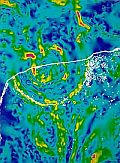Warning: A long scientific sentence without humor! (Yes, I need that from time to time.)
 Astronomers have now found with calculations of asteroid orbits, chemical examinations of asteroids that crashed on Earth and temporal distribution of impacts also on Moon, Mars and Venus that probably the collision of an asteroid with a diameter of 170 km, called Baptistina, with a 60 km large one 160 (+30/-20) million years ago created 300 large fragments over 10 km (and many smaller ones) including the one that impacted near Chicxulub (Mexiko) 65 million years ago, which most likely was mainly responsible for the extinction of the dinosaurs.
Astronomers have now found with calculations of asteroid orbits, chemical examinations of asteroids that crashed on Earth and temporal distribution of impacts also on Moon, Mars and Venus that probably the collision of an asteroid with a diameter of 170 km, called Baptistina, with a 60 km large one 160 (+30/-20) million years ago created 300 large fragments over 10 km (and many smaller ones) including the one that impacted near Chicxulub (Mexiko) 65 million years ago, which most likely was mainly responsible for the extinction of the dinosaurs.
Quite interesting how things like that can be determined after so long periods of time… More info on Spiegel Online (German), original article from Nature.